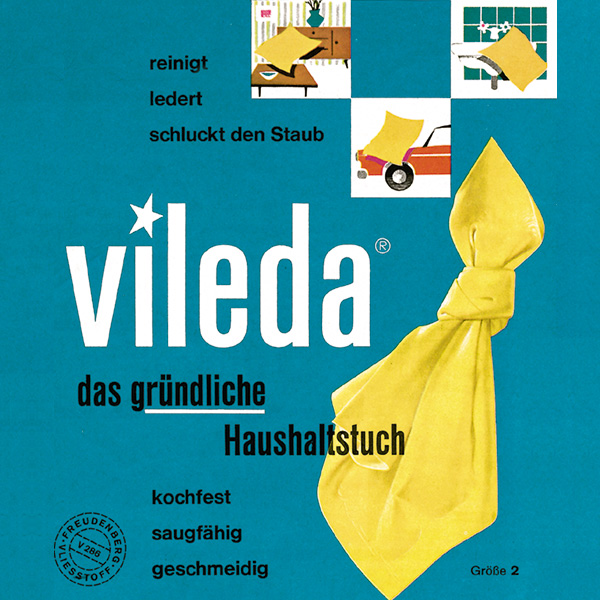- Markets
- Materials
- Innovations
- Company
- News & Stories
- Events
- Career
From nonwovens pioneer to leading supplier of technical textiles
Freudenberg Performance Materials milestones
The invention of nonwoven fabric can be traced back to Freudenberg Performance Materials. In 1938, the company began developing substrates for synthetic leather and by 1948 Vlieseline interlinings and the Vileda window cloth had joined Freudenberg’s portfolio. Today, the company is a leading global supplier of technical textiles for a wide range of markets and applications.
The milestones of success:
Freudenberg acquires 100 percent of the shares in Low & Bonar PLC, London, United Kingdom, and further expand its technological know-how.
Freudenberg Performance Material has signed a final agreement to acquire 100 percent of the shares of Filc, a Slovenian producer of needle punch nonwoven textiles and laminated materials with a focus on the automotive and construction industry.
Freudenberg Performance Materials acquires Polymer Health Technology (PHT) in Ebbw Vale (UK), the leading specialist for polyurethane foam systems used in wound care.
The successful Freudenberg Group companies Freudenberg Nonwovens and Freudenberg Politex Nonwovens merge to form the business group Freudenberg Performance Materials.

Freudenberg Nonwovens acquires the Hänsel brand from Hänsel Textil GmbH, Iserlohn (Germany) including all patents and sales companies in Italy, Romania, Bulgaria, Sri Lanka and Germany.

Freudenberg Politex Nonwovens opens a new production line in Nizhny Novgorod, Russia, for the production of spunbonded nonwovens for the construction industry.
In Weinheim (Germany) a pilot plant for the production of separators for lithium-ion batteries is put into operation.
Freudenberg Nonwovens launches a sustainable, lightweight carpet backing system based on Lutraflor® technology. The carpet backing system represents a new generation of nonwovens for automotive carpets that set standards in terms of weight, price and sustainability.

Freudenberg Nonwovens commissions an innovative production plant at the site in Taiwan.
Freudenberg Nonwovens takes over Scimat Ltd., Swindon (UK), the world’s leading supplier of battery Separators.

Freudenberg Politex Nonwovens founds Freudenberg Politex near Nizhny Novgorod (Russia). Freudenberg Politex Nonwovens now has six production sites: Novedrate and Pisticci in Italy, Colmar in France, Lodz in Poland, Macon in the United States (Freudenberg Texbond LP) and Nizhny Novgorod in Russia.
Freudenberg Nonwovens takes over all shares of Freudenberg Politex Nonwovens SpA with production locations in Italy, Poland and France. The company had been a joint venture with the Politex Group since 1997, to which Freudenberg had added its Colmar plant.
Freudenberg Nonwovens takes over all shares in the joint venture First PET Rethmann and integrates the business into Freudenberg Politex Nonwovens, Italy.
Freudenberg Nonwovens invests 40 million Euros in new production plants in Spain and Weinheim (Germany).
With the Rethmann Group in Selm (Germany), Freudenberg Nonwovens forms the joint venture First PET Rethmann for producing nonwovens made from recycled PET bottles.
Manufacture of nonwovens made from recycled PET bottles commences at the Freudenberg Politex Nonwovens SpA site in Novredate (Italy).

Using this innovative technology, Freudenberg Nonwovens creates completely new microfilament textiles with a wide range of outstanding application possibilities. The novel microfilament textiles are hydroentangled using a special technology. A single continuous process generates a textile surface from the polymer granules. These microfilament textiles are perfect for a wide range of applications e. g. apparel, home textiles (anti-allergy encasings), cleaning cloths or synthetic leather.
The Italian company Marelli & Berta, manufacturer of woven interlining materials, becomes part of Freudenberg Nonwovens.

Together with the Politex Group, Freudenberg Nonwovens forms Freudenberg Politex Nonwovens SpA in Novedrate (Italy) for the production of polyester nonwovens. Freudenberg Spunweb S.A. in Colmar (France) is assigned to the new Company.
Freudenberg Nonwovens starts exploratory talks with the Politex Group headquartered in Novedrate (Italy).

Freudenberg Nonwovens founds a joint venture with the Japanese partner Japan Vilene Company (JVC) for the production of interlining nonwovens for the apparel industry in Suzhou (China). The plant opens in 1996.

Freudenberg Nonwovens acquires the Colmar plant from Rhone Poulenc. It bears the company name Freudenberg Spunweb S.A..

A new technical center opens in Weinheim (Germany) for process development of staple-fiber nonwovens, including hydroentanglement.
Freudenberg Nonwovens takes over Intece (later Freudenberg Não Tecidos Ltda.), Brazil’s market leader for staple-fiber nonwovens.

Production begins at the first non-European Freudenberg Nonwovens plant for spunbonded polyester nonwovens in Durham, North Carolina (USA).

Production of wet-laid nonwovens begins in Neuenburg (Germany).
These nonwovens are manufactured at the new plant in Kaiserslautern (Germany). The innovative technology enables Freudenberg Nonwovens to develop nonwovens for new application fields, e. g. wound dressings in medical technology or harvest nonwovens in agriculture.

These nonwovens are manufactured according to the method of Dr. Ludwig Hartmann. He devised a cost efficient solution for processing spunbond nonwoven fabrics. The method he developed allowed nonwovens to be made from granulate raw material in one continuous production process.

Freudenberg Nonwovens starts a joint venture with the Japan Vilene Company in Tokyo. The partnership also includes intensive technology transfer.

Freudenberg Nonwovens builds its first foreign production company in Pellon (USA).

Vlieseline interlinings and the Vileda window cloth are launched. The name “Vileda” is actually a modification of the German “wie Leder” (“like leather”). The production of dry-laid staple-fiber nonwovens starts in Weinheim.
As a response to the leather shortage Freudenberg develops the synthetic latex artificial leather Viledon as a substitute material for bags and suitcases under the leadership of chemist Dr. Carl Ludwig Nottebohm.

At Freudenberg in Weinheim (Germany), chemist Dr. Carl-Ludwig Nottebohm begins the development of nonwoven fabrics.
